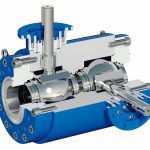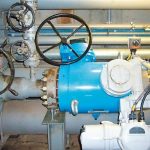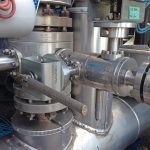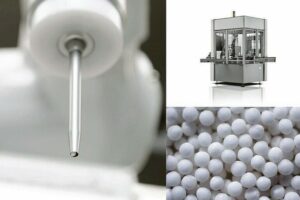Firmen im Artikel
Especially in existing plants and aging facilities, reliable shut-off solutions with supplementary safety features, a design adapted to known conditions and minimal installation effort are the key to success. Where two independent and testable barriers are needed, the Twin Ball Valve developed by Hartmann Valves provides a compact and economic alternative for installing multiple valves. It consists of two integrated ball valves in one body, which can additionally be equipped with two barriers at each ball. Compared to a standard valve, safety can be quadrupled in this way with only minimal effort. Thanks to the so-called studded design with a closed flange, the valve can be shortened to the length of a single standard valve. With its space saving design, the solution is also ideal as a tailor-made replacement in existing plants with space limitations.
Double piston design
If equipped with the Double Isolation and Bleed (DIB) function, each ball valve seals on both the upstream and the downstream side, making a total of four barriers against fluid pressure. If a standard valve leaks at the inlet, medium enters the valve cavity. This leads to increased pressure until the seat ring at the outlet is pushed away from the ball, resulting in a leak across the valve to the outlet. Unlike standard designs, a DIB-equipped valve does not allow the seat ring at the outlet to lift off; instead, the higher pressure also increases the force which pushes the outlet seal towards the ball. A leak at the inlet seal cannot develop further and the medium is trapped in the valve body.
Metal-to-metal sealing
Like all Hartmann valves, the Twin Ball Valve has a bubble-tight, metal-to-metal seal between the ball and the seat ring. This sealing system is gas-tight and conforms to leakage rate A or 0, even with frequent switching. Furthermore, it is characterised by outstanding longevity and low maintenance requirements as it is more resistant to abrasion and erosion. It is much more robust and durable than PMSS or soft-sealing ball valves. Optimal material selection, surface treatment and special coatings also contribute to the long service life. Less downtime and extended maintenance cycles mean lower life cycle costs. These benefits pay off especially under extreme process conditions: Hartmann ball valves and Twin Ball Valves are always adapted to the customer’s specific requirements, for instance temperatures from -200 to +550 °C, pressures up to 700 bar or aggressive media.
Custom-made for DEA
A very high level of safety and availability are crucial in gas storage facilities too. Approximately 800 Hartmann gas-tight ball valves are installed at Europe’s deepest gas store, the Upper Bavarian DEA facility in Wolfersberg near Munich. About forty Twin Ball Valves, equipped with a double barrier and two completely separate isolating mechanisms in one body, ensure maximum safety. A special, ultra-compact version of the Twin Ball Valve was designed when an old isolating section of the main injection line had to be renewed. This line consisted of one welded and one flanged ball valve, but exchanging the former would have entailed a long downtime. Hartmann therefore engineered a DN 250/PN 250 version of the Twin Ball Valve with the same length as the original standard valve. Following a successful trial period, more ultra-compact Twin Ball Valves with identical dimensions to the original valves were installed in other parts of the facility.
For extreme conditions
A high-temperature application for pure oxygen provides another example of how Hartmann’s special ball valves and Twin Ball Valves can be used in extreme process conditions. A few years ago, Yara Germany carried out a major optimisation of the processes at their ammonia plant in Brunsbüttel, which is the only one of its kind in the world: both gasification lines can be run on either natural gas or oil. The five-inch Hartmann shut-off ball valves installed there are especially designed for the challenging combination of pure oxygen, high temperatures and steam. They are made of Inconel 625 (solid material) and equipped with a Twin Ball Valve at the body of the main valve, allowing both seals to be tested independently without removing the valve.
These EIGA-compliant, Atex Zone 2-approved valves are equipped with two barriers (seat rings). Due to the limited space available, the main valve is extremely compact with an integral flange on one side.
In addition to these typical examples, Twin Ball Valves are increasingly also installed as wellhead components in the oil, gas and petrochemical industries as well as in deep geothermal applications. Once again, the integral design with fewer flange connections increases safety and reduces the weight and length.
Online search: cpp0318hartmann
Hall 3, Booth J02












